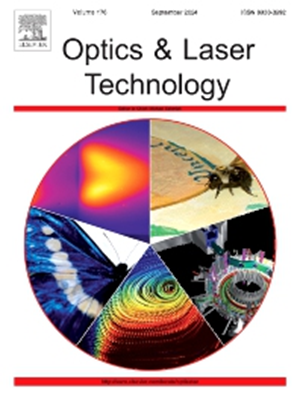Effects of laser cutting on microstructure, hardness and magnetic properties of Fe-based amorphous ribbons
IF 4.6
2区 物理与天体物理
Q1 OPTICS
引用次数: 0
Abstract
Fe-based amorphous alloys are extensively utilized in electromagnetic components owing to their outstanding mechanical and magnetic properties, holding significant potential in solid-state transformers and amorphous motors. However, the deterioration of magnetic properties after processing has hindered the applications of these alloys. Traditional processing methods can induce deformation near the cutting edge and significant crystallization, severely degrading the magnetic property. In contrast, the laser cutting method offers minimal heat effects, a non-contact approach, and low magnetic property deterioration, making it as the optimal technique for cutting Fe-based amorphous alloys. In this research, a continuous-wave infrared laser cutting technique is employed to cut the amorphous ribbons into a ring shape at different laser powers and laminated magnetic cores should be prepared. The results reveal the presence of three distinct zones from the cutting edge to the substrate, namely the melted zone, heat affected zone and basis zone. Notably, Only the α-Fe(Si) phase is formed in the crystallization zone due to the relatively short duration of the laser cutting process for the amorphous ribbon and average grain sizes gradually decreases from the cutting edge to the basis zone. Furthermore, the amorphous-nanocrystalline dual-phase resulting from laser cutting exhibits a high hardness of approximately 1035 HV at 20 μm from the cut edge. Additionally, the laser-cut laminated cores at a power of 75 W exhibit excellent combined properties, including width of the crystallization zone of 80 μm and a low loss of 53.96 W/kg (200 mT, 100 kHz). This research offers a theoretical foundation for the industrialization of solid-state transformers and amorphous motors.
激光切割对铁基非晶带显微组织、硬度和磁性能的影响
铁基非晶合金由于其优异的机械性能和磁性能,在电磁元件中得到了广泛的应用,在固态变压器和非晶电机中具有很大的应用潜力。然而,加工后磁性能的恶化阻碍了这些合金的应用。传统的加工方法会导致切削边缘附近的变形和明显的结晶,严重降低磁性能。相比之下,激光切割方法具有最小的热效应,非接触方法和低磁性能劣化,使其成为切割铁基非晶合金的最佳技术。在本研究中,采用连续波红外激光切割技术,在不同的激光功率下,将非晶带切割成环形,并制备层压磁芯。结果表明,从切削刃到基体存在三个不同的区域,即熔化区、热影响区和基区。值得注意的是,由于激光切割过程持续时间较短,非晶带在结晶区只形成α-Fe(Si)相,平均晶粒尺寸从切割边缘到基区逐渐减小。此外,激光切割产生的非晶纳米晶双相在距离切割边缘20 μm处显示出约1035 HV的高硬度。此外,在功率为75 W时,激光切割的层压芯具有优异的综合性能,包括结晶区宽度为80 μm,损耗低至53.96 W/kg (200 mT, 100 kHz)。该研究为固态变压器和非晶电机的产业化提供了理论基础。
本文章由计算机程序翻译,如有差异,请以英文原文为准。
求助全文
约1分钟内获得全文
求助全文
来源期刊
CiteScore
8.50
自引率
10.00%
发文量
1060
审稿时长
3.4 months
期刊介绍:
Optics & Laser Technology aims to provide a vehicle for the publication of a broad range of high quality research and review papers in those fields of scientific and engineering research appertaining to the development and application of the technology of optics and lasers. Papers describing original work in these areas are submitted to rigorous refereeing prior to acceptance for publication.
The scope of Optics & Laser Technology encompasses, but is not restricted to, the following areas:
•development in all types of lasers
•developments in optoelectronic devices and photonics
•developments in new photonics and optical concepts
•developments in conventional optics, optical instruments and components
•techniques of optical metrology, including interferometry and optical fibre sensors
•LIDAR and other non-contact optical measurement techniques, including optical methods in heat and fluid flow
•applications of lasers to materials processing, optical NDT display (including holography) and optical communication
•research and development in the field of laser safety including studies of hazards resulting from the applications of lasers (laser safety, hazards of laser fume)
•developments in optical computing and optical information processing
•developments in new optical materials
•developments in new optical characterization methods and techniques
•developments in quantum optics
•developments in light assisted micro and nanofabrication methods and techniques
•developments in nanophotonics and biophotonics
•developments in imaging processing and systems

 求助内容:
求助内容: 应助结果提醒方式:
应助结果提醒方式:


